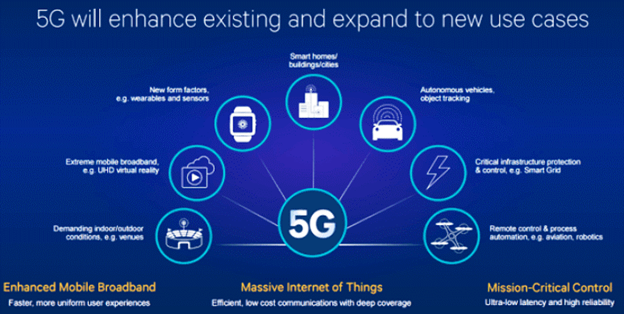Blitz News Digest
Stay updated with the latest trends and insights.
Zooming into the Future with 5G Technology
Discover how 5G technology is revolutionizing our world! Dive into the future and unlock the potential of lightning-fast connectivity.
How 5G Technology is Revolutionizing Communication
5G technology is transforming the landscape of communication by providing faster data transfer speeds and lower latency. With speeds reaching up to 10 Gbps, 5G networks enable users to download large files in seconds, stream high-definition videos without buffering, and engage in real-time virtual experiences. These enhancements are not only beneficial for individual consumers but also significantly improve operational efficiency for businesses. For instance, industries such as healthcare and manufacturing are leveraging 5G's capabilities to facilitate remote surgeries and automate production lines, showcasing its potential to revolutionize various sectors.
Moreover, the implementation of 5G technology is paving the way for the Internet of Things (IoT), connecting an unprecedented number of devices and allowing for smarter cities and homes. This connectivity empowers everything from smart appliances to autonomous vehicles, enhancing convenience and safety in everyday life. As more devices come online, the demand for instantaneous communication will intensify, and 5G is uniquely positioned to meet this challenge. In summary, 5G is not just an upgrade; it is a foundational technology set to redefine how we communicate, work, and live.

The Impact of 5G on Smart Cities and IoT
The advent of 5G technology is poised to significantly transform the landscape of smart cities and the Internet of Things (IoT). By providing lightning-fast network speeds and lower latency, 5G facilitates real-time communication between devices, enabling seamless interconnectivity. This robust infrastructure supports various applications, including smart transportation systems, energy management, and public safety. For instance, with 5G, traffic lights can communicate with vehicles to optimize traffic flow, reducing congestion and enhancing overall urban mobility.
Moreover, 5G's impact extends beyond just improved connectivity; it also paves the way for advanced data analytics and artificial intelligence integration within IoT devices. As cities become more efficienct, they can harness the power of massive amounts of data generated by connected devices to make informed decisions. For example, environmental sensors can monitor air quality in real-time, allowing city planners to implement timely interventions. Consequently, the combination of 5G technology and IoT will not only enhance operational efficiencies but also improve the quality of life for residents in smart cities.
What You Need to Know About 5G: Myths and Facts
5G technology has sparked a variety of myths and misconceptions that can cloud public understanding of its benefits and functionalities. One prevalent myth is that 5G causes health problems due to increased exposure to radiofrequency radiation. However, numerous scientific studies and reviews conducted by health organizations have consistently found that 5G is safe and operates within regulated limits. Another myth suggests that 5G will lead to the destruction of our privacy, but in reality, 5G has the potential to enhance privacy protections through improved network security measures and advanced encryption techniques.
Beyond the myths, it’s essential to recognize the facts surrounding 5G. Here are some key points:
- 5G offers significantly faster data speeds compared to previous generations, allowing for quicker downloads and smoother streaming experiences.
- This technology supports a higher density of devices, making it ideal for urban areas and the growing Internet of Things (IoT) ecosystem.
- Deployment of 5G networks can lead to economic growth, creating jobs and enabling new innovations across various industries.